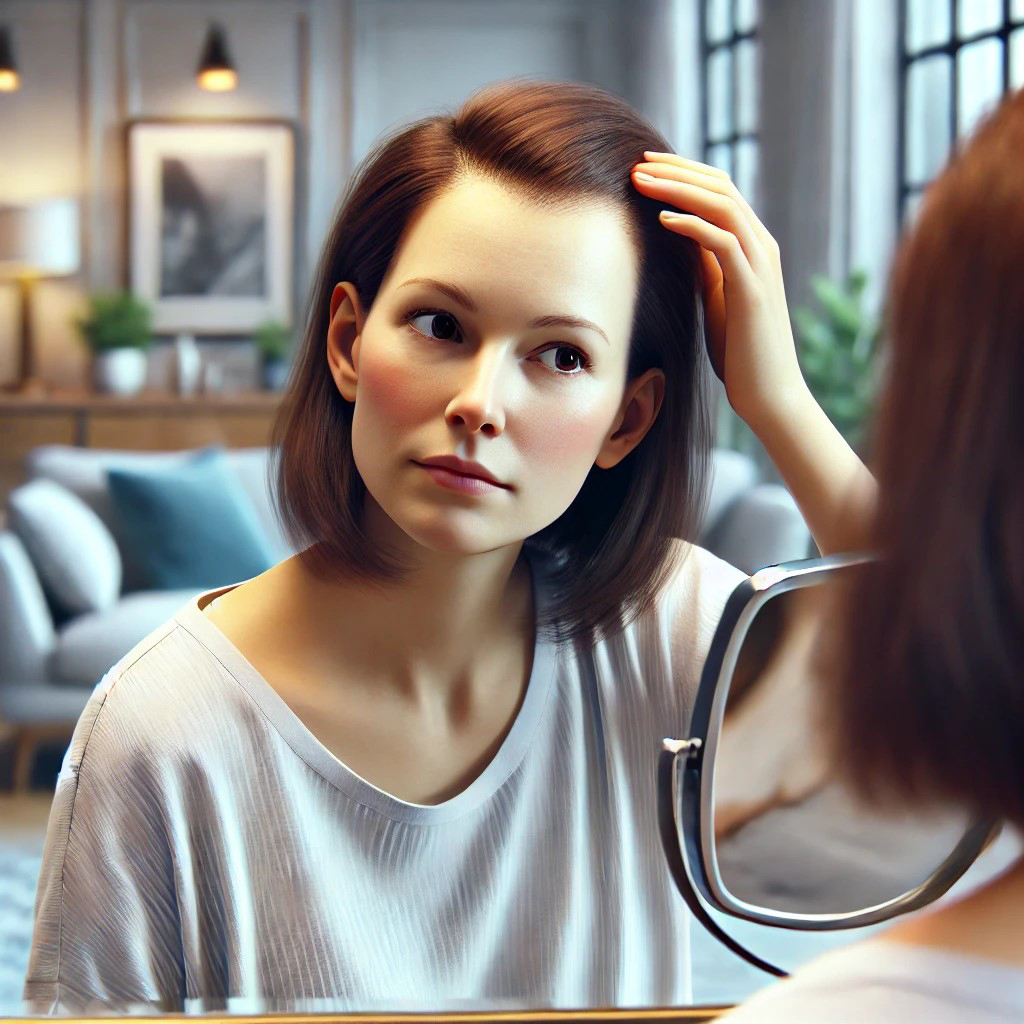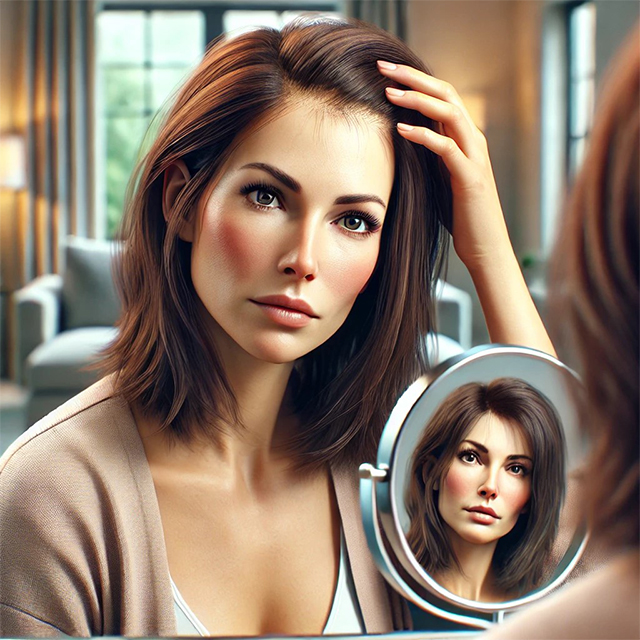Hair loss in women is a multifaceted issue that affects millions worldwide. It can have significant emotional and psychological impacts, making understanding its causes, preventive measures, and treatment options crucial.
This article delves into these aspects comprehensively, offering insights into how women can manage and combat hair loss effectively.

Causes of Hair Loss in Women
Hair loss in women can be attributed to various factors, including hormonal changes, genetics, medical conditions, and lifestyle choices. Understanding these causes is the first step toward effective management.
Hormonal Changes
Hormonal fluctuations are a primary cause of hair loss in women. Conditions such as pregnancy, menopause, and thyroid imbalances can significantly impact hair growth cycles.
Menopause: During menopause, the body experiences a decline in estrogen levels, which can lead to hair thinning. Estrogen plays a crucial role in maintaining hair growth, and its reduction disrupts the hair growth cycle.
Postpartum Hair Loss: After pregnancy, many women experience significant hair shedding. This condition, known as telogen effluvium, occurs due to the sudden hormonal changes post-delivery. The high levels of estrogen during pregnancy keep hair in the growth phase, but once the levels drop after childbirth, hair enters the shedding phase.
Genetics
Genetic predisposition is another significant factor. Female pattern baldness, also known as androgenetic alopecia, is hereditary and can be inherited from either parent. This condition typically presents as a diffuse thinning over the crown and frontal areas of the scalp.
Medical Conditions
Certain medical conditions can lead to hair loss. These include:
- Alopecia Areata: An autoimmune disorder where the immune system attacks hair follicles, causing hair to fall out in small patches.
- Polycystic Ovary Syndrome (PCOS): This condition causes hormonal imbalances that can lead to hair thinning.
- Thyroid Disorders: Both hypothyroidism and hyperthyroidism can result in hair loss due to hormonal imbalances affecting hair growth.
Lifestyle and Environmental Factors
Lifestyle choices and environmental factors also play a crucial role in hair health. Poor nutrition, stress, and harsh hair treatments can weaken hair and lead to increased shedding. Nutrient deficiencies, particularly in iron, vitamin D, and proteins, can significantly affect hair health.
Preventive Measures
Preventing hair loss involves a holistic approach that includes dietary management, stress reduction, and the use of gentle hair care practices.
Healthy Diet
A balanced diet rich in essential vitamins and minerals is vital for maintaining healthy hair. Key nutrients include:
- Iron: Essential for carrying oxygen to hair follicles. Iron deficiency can lead to anemia, which causes hair loss.
- Vitamin D: Promotes healthy hair follicles. Deficiency in vitamin D is linked to alopecia areata.
- Protein: Hair is primarily made of protein (keratin). Adequate protein intake is necessary for hair strength and growth.
- Omega-3 Fatty Acids: Found in fish, flaxseed, and walnuts, these fatty acids nourish hair and support its growth.
Incorporating these nutrients into your diet can significantly reduce the risk of hair loss.
Stress Management
Chronic stress can lead to hair loss conditions such as telogen effluvium. Managing stress through relaxation techniques like yoga, meditation, and regular exercise can help maintain hair health.
Gentle Hair Care Practices
Using gentle hair care products and avoiding harsh treatments can prevent hair damage. Tips include:
- Avoiding Heat Styling: Excessive use of heat styling tools can damage hair and lead to breakage.
- Using Sulfate-Free Shampoos: Sulfates can strip the hair of natural oils, leading to dryness and brittleness.
- Regular Scalp Massages: Stimulates blood circulation to the scalp, promoting hair growth.
Treatments for Hair Loss

Several effective treatments can help manage and reverse hair loss in women. These include topical treatments, oral supplements, laser therapy, and cosmetic solutions.
Topical Treatments
Topical treatments are applied directly to the scalp and hair to promote growth and reduce hair loss. Some widely used products include:
Minoxidil: An over-the-counter medication approved by the FDA for treating hair loss. It stimulates hair follicles and prolongs the growth phase of hair.
Nanoxidil: A newer alternative to Minoxidil, it has a similar mechanism of action but with a different molecular structure, potentially offering better absorption and fewer side effects.
Hair Growth Shampoos and Conditioners: Products like Neofollics, Revita, and Foligain contain ingredients that nourish the scalp and promote hair growth.
Oral Supplements
Oral supplements provide essential nutrients that support hair health from within. Popular options include:
Biotin: A B-vitamin that strengthens hair and nails.
Viviscal: Contains a marine complex called AminoMar, along with vitamins and minerals, to support hair growth.
Neofollics Tablets: These tablets combine several ingredients known to promote hair growth, including saw palmetto, biotin, and zinc.
Low-Level Laser Therapy (LLLT)
LLLT uses laser light to stimulate hair follicles and promote hair growth. Devices like the Theradome laser helmet have been approved by the FDA for this purpose. The therapy is non-invasive and can be used at home, making it a convenient option for many women.
Microneedling
Microneedling involves using a dermaroller with tiny needles to create micro-injuries on the scalp. This process stimulates the release of growth factors that promote hair growth and enhance the absorption of topical treatments.
Cosmetic Solutions
For immediate results, cosmetic solutions can conceal thinning areas and enhance hair volume. These include:
Hair Fibers: Products like Toppik and Beaver hair fibers attach to existing hair, creating the appearance of thicker, fuller hair.
Scalp Shaders and Color Sprays: These products color the scalp to reduce the contrast between hair and scalp, making hair appear denser.
Conclusion
Hair loss in women is a complex issue with various underlying causes. Understanding these causes, adopting preventive measures, and utilizing effective treatments can help manage and combat hair loss. A combination of healthy lifestyle choices, appropriate hair care practices, and targeted treatments can significantly improve hair health and reduce hair loss. For personalized advice and product recommendations, consulting a hair growth specialist or dermatologist is recommended.
